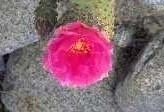Tiger-pear
(Opuntia aurantiaca)

Description
Opuntia aurantiaca, commonly known as tiger-pear, jointed cactus or jointed prickly-pear, is a species of cactus from South America. The species occurs naturally in Argentina, Paraguay and Uruguay and is considered an invasive species in Africa and Australia. It was declared a Weed of National Significance by the Australian Weeds Committee in April 2012, and was reported by the Committee to be the most troublesome of all cactus species in New South Wales and the worst Opuntia species in Queensland. It is currently controlled biologically in Australia using the cochineal insect Dactylopius austrinus, and to a lesser extent by the larvae of two moths, Cactoblastis cactorum and Tucumania tapiacola. Opuntia, commonly called prickly pear or pear cactus, is a genus of flowering plants in the cactus family Cactaceae. Prickly pears are also known as tuna (fruit), sabra, nopal (paddle, plural nopales) from the Nahuatl word nōpalli for the pads, or nostle, from the Nahuatl word nōchtli for the fruit; or paddle cactus. The genus is named for the Ancient Greek city of Opus, where, according to Theophrastus, an edible plant grew and could be propagated by rooting its leaves. The most common culinary species is the Indian fig opuntia (O. ficus-indica). O. ficus-indica is a large, trunk-forming, segmented cactus that may grow to 5–7 m (16–23 ft) with a crown of over 3 m (10 ft) in diameter and a trunk diameter of 1 m (1 yd). Cladodes (large pads) are green to blue-green, bearing few spines up to 2.5 cm (1 in) or may be spineless. Prickly pears typically grow with flat, rounded cladodes (also called platyclades) containing large, smooth, fixed spines and small, hairlike prickles called glochids that readily adhere to skin or hair, then detach from the plant. The flowers are typically large, axillary, solitary, bisexual, and epiperigynous, with a perianth consisting of distinct, spirally arranged tepals and a hypanthium. The stamens are numerous and in spiral or whorled clusters, and the gynoecium has numerous inferior ovaries per carpel. Placentation is parietal, and the fruit is a berry with arillate seeds. Prickly pear species can vary greatly in habit; most are shrubs, but some, such as Opuntia galapageia of the Galápagos, are trees.
Taxonomic tree:







